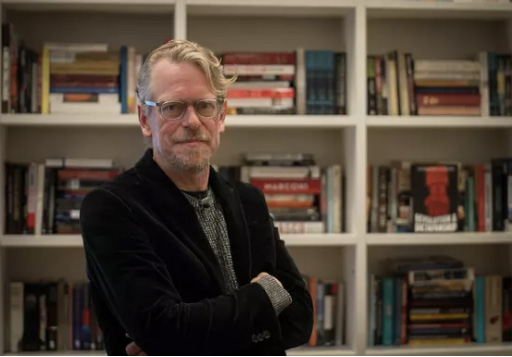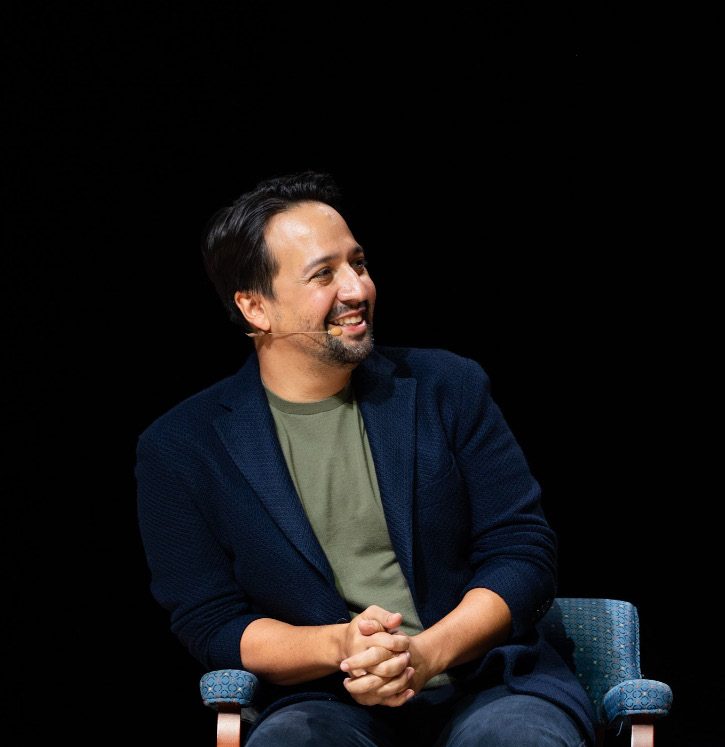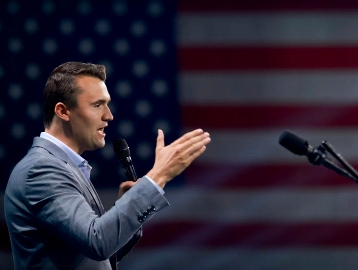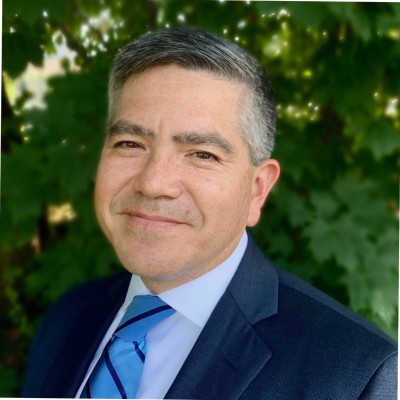
Following a yearly tradition of a Constitutional Day Lecture, Hamilton College hosted Lucan Ahmad Way, Distinguished Professor of Democracy at the University of Toronto to deliver the College’s annual talk. The lecture took place in the Chapel on Sept. 11, welcoming an audience of students, faculty, staff and local residents.
The presentation, titled “The Great Abdication: America’s Descent into Authoritarianism and How to Reverse It,” previews a new book project from Way, Steven Levitsky and Daniel Ziblatt. This project underscores how political leaders and influential social elites have stepped away from their ability to challenge the “authoritarian” regime and, in turn, have effectively “abdicated” their duties.
While the book project currently exists in its preliminary stages, Way provided the audience with an engaging presentation, clearly underlining the thesis of the publication. He began by providing context on the role of democracy in America. He dug further into the core assumption that at the center of the nation lies uninterrupted democratic ideology. Ultimately, he claimed that “standard minimum political science definitions of democracy” would argue that America truly began as a democracy in 1965, alongside the expansion of suffrage to all adults.
In standard political science theory, Way explains, scholars, prior to the 2024 Election, assumed a 0% chance of the breakdown of American democracy. “There are… substantive and theoretical reasons to believe that American democracy should be robust…very strong institutions…strong rule of law, professionalized military, which has no history of intervening in politics, strong degrees of federalism… robust, strong civil society backed by a private sector,” explained Way. “The United States has far more tools to resist authoritarianism than the vast majority of countries in the world…And yet, democracy has broken down, just in the last 6 or 7 months.”
This breakdown of democracy, according to Way, can be attributed to a variety of factors. He began by outlining Trump’s weaponization of the state, including targeted investigations by the Federal Bureau of Investigation (FBI) and Department of Justice (DOJ), attacks on law firms in the form of clearance suspensions and bars from Federal buildings. Furthermore, attempts to strengthen the media through lawsuits and investigations by the Federal Communications Commission (FCC) and attacks on universities and on civil liberties, through the form, for example, of deportations, continue to highlight a rise of state weaponization. Not only are the actions themselves, he argues, significant, but so is the sheer speed of this transition, one he describes as “authoritarian.” In comparison with other countries, Turkey and Hungary, who eventually fell into authoritarianism, this is a “truly shocking” timeline.
Way highlighted how this transition does not represent “old-fashion dictatorship” but “competitive authoritarianism,” which underscores a more broad shift in what authoritarianism leadership looks like globally. These states experience the weaponization of the state against opposition and violations of civil liberties; however, these states do run meaningful and uncertain (though sometimes unfair) elections.
In this way, not only are federal investigations and more outright attacks facilitating this authoritarian transition, but also indirect attacks. Funders, potential supporters and other groups witness certain organizations growing under scrutiny by the government and, in turn, aim to protect themselves through self-censorship and scaling back, or altogether cancelling, certain programing. Media Matters, for instance, a key civic organization pioneering watchdog jounalism, has recently been forced to let go many of its workers and scale back their work due to attacks and loss of funding.

While it appears to be a bleak road ahead, Way argues that much can be done. Other nations have demonstrated the possibility of pushing against authroritarianism and working towards a more democratic future. For example, over the past ten years, South Korea and Brazil have each demonstrated defenses of democracy, the former societally and the latter institutionally.
Furthermore, while the phenomenon of the abdication may appear to be a highly contemporary development, precedent exists as recently as World War II, when the pro-democratic and Catholic Zentrum party voted to provide Hitler with dictatorial powers. In today’s age, a similar trend can be observed in the actions of Jeff Bezos, Founder of Amazon, who upon purchasing The Washington Post, cancelled the paper’s endorsement of Kamala Harris and criticisms of President Trump in its editorial pages, despite being a supporter of progressive causes and democracy as recently as 2024.
Through two major steps, Way explained, abdication acts as a near-stepping stone to authoritarianism: autocratic rise to power and authoritarian entrenchment in power. The former effectively “opens the door…legitimizes [discredited people, like Trump was in 2021], gives them the keys to the throne” a similar framework seen under the regime of Hitler. The latter takes place once autocrats are already in power, providing them with means of empowerment and silencing, seen in the Zenturm’s allowance of new dictatorial behavior in Germany. This silencing act is also dangerous as it both discourages resistance from other actors and normalizes the behavior of authoritarians—“no one wants to be the only guy out there resisting, you need company, it’s dangerous to be all by yourself.” Furthermore, Way explained, when “an authoritarian action happens and no one resists… people don’t pay attention, they assume this is something normal.”
In this way, abdication “killed democracy in two steps.” First in President Trump’s rise to power, beginning on the Jan. 6 assault on the capital. Despite President Trump’s low approval ratings, the Supreme Court “opened the door” by granting him immunity and weakening investigations. The second step, Way described, is an “entrenchment of power” wherein loyalists are empowered, while opposition is silenced.
This abdication, while dangerous, can be explained. Way breaks these decisions into three categories: ideological convergence, opportunism and a collective action problem. Of the collective action problem, Way noted, “What’s rational for the individual is not rational for the country.”
The United States is a unique target of abdication for various reasons, explained by Way, including a lack of recent memory of authoritarianism, generating a sense of overconfidence and complacency. When compared to nations like South Korea and Brazil, who were able to successfully fend off authoritarianism, their recent memory of those leaders is far stronger than that of the U.S.
Finally, Way outlined two possible outcomes. The first, deemed the “optimistic” and “more likely” scenario, wherein authoritarianism is not consolidated, the Democrats win power in the coming years, but the country experiences a less than ideal shift between dysfunctional democracy and competitive authoritarianism. The second option, labeled the “pessimistic” scenario, was broken down into two main options: a complete dictatorship or a large-scale civil conflict.
In order to resolve these harrowing outcomes, several options remain for the general public. First, individuals must “fight battles that [they] are likely to lose in the first round,” to bring attention to the issues at hand, build momentum for others to join the cause and resist the normalization of the crisis. Second, people can engage in peaceful protest, support activists and work to decrease the cost of collective action for everyone.
The talk concluded by opening the floor to questions, which made up a sizable portion of the hour and a half lecture. Way answered questions from audience members covering a range of topics, including the best way to resist these changes, the motivation behind President Trump’s statements challenging democracy and the role of allies, like Canada, in supporting the U.S. through its struggles.
Guests to the event asked over 20 questions. They expanded on Way’s frameworks and developed new ideas for action. Overall, the talk invited community members to truly reflect on the current state of the nation and wonder how they may be able to shift the road back towards democracy, once and for all.

























